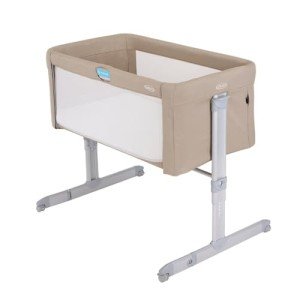11 "Faux Pas" You're Actually Able To Create Using Your Bedside Cot For Infants

The Importance of Bedside Cots for Infants: A Comprehensive Guide
As new parents start their parenting journey, they are confronted with a myriad of choices concerning their infant's sleep arrangements. Among these options, the bedside cot stands out for its myriad of advantages. This post checks out the significance of bedside cots, discusses their advantages and downsides, answers often asked concerns, and includes a relative table to assist parents make notified decisions.
What Is a Bedside Cot?
A bedside cot is a sleep space developed to be positioned next to the parents' bed, permitting for easy access to the infant during the night. These cots feature adjustable height settings, enabling them to line up with the height of the adult bed. Often, they can be connected securely to the bed or remain close by, offering a safe yet accessible sleep environment for the baby.
Kinds Of Bedside Cots
- Co-Sleeping Cots: These cots connect firmly to the parents' bed, enabling close proximity while guaranteeing the baby has their own safe sleeping space.
- Freestanding Cots: These are located beside the bed however do not attach straight. They still offer a convenient reach for feeding and comforting.
- Portable Cots: These cots are lightweight and created for travel, typically including foldable designs and easy-transport capabilities.
Advantages of Using a Bedside Cot
Bedside cots supply a number of advantages that can enhance both the infant's sleep experience and the parents' comfort. These include:
1. Boosted Safety
According to the American Academy of Pediatrics (AAP), having the infant sleep in the exact same room as parents, without sharing the exact same sleeping surface, considerably decreases the risk of Sudden Infant Death Syndrome (SIDS). A bedside cot uses a safe space while preserving proximity.
2. Easier Nighttime Care
When a baby is within arm's reach, feeding, diaper modifications, and reassuring ends up being much more convenient. Parents can rapidly soothe their infant without completely waking from sleep or leaving the bed.
3. Motivation of Bonding
The close distance provided by a bedside cot motivates bonding during nighttime feedings or comforting. This can cultivate a complacency for the infant and assistance develop stronger emotional connections.
4. Space-saving Design
Many bedside cots are created to be compact, making them ideal for small home where a full-sized crib might not fit. They can be quickly moved or kept when not in use.
5. Versatile Functionality
A lot of bedside cots can be adjusted in height and typically include detachable sides, making them adaptable for numerous usages as the kid grows or family needs change.
Downsides of Bedside Cots
Regardless of their advantages, there are some drawbacks to think about when selecting a bedside cot:
1. Minimal Lifespan
Bedside cots typically have a much shorter life-span than basic cribs, often accommodating infants just as much as a particular weight or height. Parents might need to shift to a complete crib faster than expected.
2. Stability Concerns
If not firmly attached or properly positioned, a bedside cot may present safety concerns. Parents should ensure that the cot is steady and well-aligned with the bed.
3. Adjustment Period
Some infants may take time to get used to sleeping in a cot, especially if they are utilized to closer contact. Parents might need to be client as their child adapts.
How to Choose the Right Bedside Cot
When picking a bedside cot, parents ought to think about the following requirements:
- Safety Standards: Ensure the cot abides by all security regulations.
- Adjustability: Look for height-adjustable functions that align with your bed.
- Building and construction Material: Choose a cot that is sturdy and made of non-toxic materials.
- Alleviate of Use: Opt for designs that permit one-handed operation when accessing the infant.
Table: Comparison of Popular Bedside Cots
| Feature | Co-Sleeping Cot | Freestanding Cot | Portable Cot |
|---|---|---|---|
| Attachment to Bed | Yes | No | No |
| Adjustability | Yes | Yes | Yes |
| Travel-Friendly | No | No | Yes |
| Life-span | 6-12 months | 18-24 months | 0-12 months |
| Price Range | ₤ 150-₤ 300 | ₤ 100-₤ 250 | ₤ 50-₤ 150 |
Regularly Asked Questions (FAQs)
1. Are bedside cots safe for my baby?
Yes, when used correctly and according to safety standards, bedside cots are safe for infants. Bedside Cot For Close Bonding is essential to guarantee that the cot is firmly located and does not posture any threat of falling.
2. At what Bedside Crib For Attachment Parenting can I shift my baby from a bedside cot to a crib?
Most parents shift their baby from a bedside cot to a crib in between 6 months and 2 years, depending on the infant's development and convenience level.
3. Can Bedside Cot For Safe Sleeping use a bedside cot for twins?
While some bedside cots are designed to accommodate more than one child, a lot of are intended for single infants. Parents of twins may need to consider using separate cots.
4. How do I maintain my bedside cot?
Regular cleaning, looking for wear and tear, and guaranteeing that all parts, such as safety straps and bed mattress, are in excellent condition, can assist preserve your bedside cot.
Choosing the right sleep plan for an infant is among the numerous decisions that new parents face. A bedside cot offers unrivaled benefit and safety while allowing for close parental interaction. Understanding the advantages, drawbacks, and features of bedside cots can empower parents to make the right choice for their family's needs. By weighing these factors alongside security precautions, parents can create a nurturing sleep environment for their youngsters.

